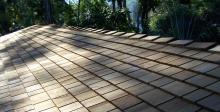Home Design Guides: Climate control
Wind ventilation and cross ventilation
Wind ventilation, also known as cross ventilation, is a simple and effective way to take advantage of the wind to keep your home cool and regulate air quality.
Natural ventilation systems
This type of ventilation takes advantage of rising heat and strategically located vents to draw air up through the top of the house, and in through the bottom of the house.
Mechanical ventilation
Mechanical ventilation (or forced ventilation) takes advantage of fans to help draw air in a particular direction to control ventilation in your home.
Mixed mode / hybrid ventilation
In many cases, the best way to ventilate a room is to combine two or more different techniques. See how mixed mode ventilation can help you ventilate for different needs.
Air infiltration
In many cases, ventilation in a house is unintentional, and comes from small gaps and crevices. This kind of ventilation, in some cases, has a big effect on a house's air quality.
Whole house fan
Whole house fans are large, ceiling mounted fans designed to help to ventilate homes by sucking warm air up into the ceiling, and bringing cool air in from vents and windows.
Ridge vents
Hot air naturally rises, and ridge vents are an effective way of allowing this heat to easily escape through the highest point in a home - the ridge of the roof.
Soffit vents
Working in conjunction with ridge vents, soffit vents can create a natural flow of ventilation in the roof cavity, which allows heat to easily escape through the top of a house.
Foundation vents
An important part of some types of ventilation is to allow cool air into the lower parts of the house. Foundation vents allow cool air in at the lowest levels of the home.
Turbine vents / whirlybirds
Turbine vents, also commonly known as whirlybirds, provide effective natural ventilation through a ducted turbine mounted on the roof of a building.
Exhaust fans
Kitchens and bathrooms can become very steamy and stuffy, and powered ventilation fans are an excellent way of providing fast, effective ventilation to these areas.
Heat recovery ventilators (HRVs)
Heat recovery ventilators (HRVs) and energy recovery ventilators (ERVs), while they do use energy, are an efficient and effective way to ventilate a tightly sealed home while maintaining the temperature.
Windows as vents
When thinking about vents it's easy to get caught up in the details and forget that the most effective ventilation in a home almost always comes from its windows.
Wing walls
While not strictly vents in their own right, strategically placed wing walls or similar mechanisms can make a big difference to the way that air is directed into a house.
Position and aperture size of vents
Where your vents and windows are located and how big they are both play a vital role in how much air is allowed to move in and out of your home.
Exhaust fans: size, speed and throughput
The size and speed of an exhaust fan can have an impact on its performance, but to choose a fan you also need to consider what it's going to be used for.
House design and orientation
The best things you can do to make sure your house is effectively ventilated are to think carefully about air flow at the design stage, and to face your house in the right direction.
Heat, humidity and ventilation
Effective ventilation can make a big difference to houses in hot and humid environments. Find out how best to use ventilation to deal with these conditions.
Indoor air quality
The most important reason to ensure that your home is properly ventilated is to ensure that the quality of the air is not making you sick, and to avoid sick building syndrome.
Energy efficient ventilation
A well-designed ventilation system, natural or powered, can help make your home far more energy efficient.






















